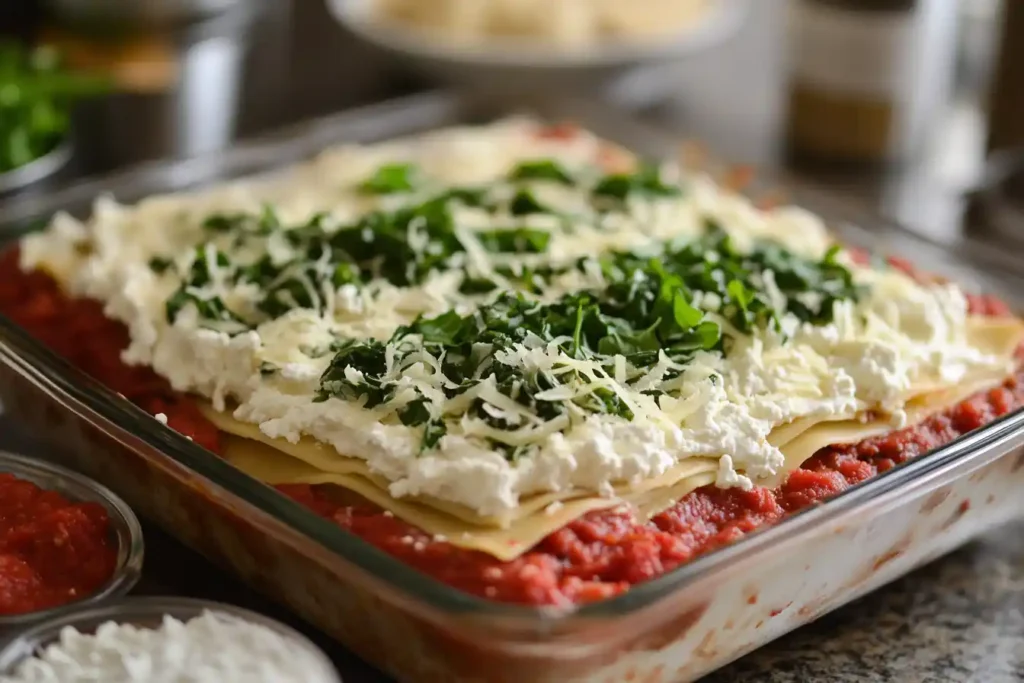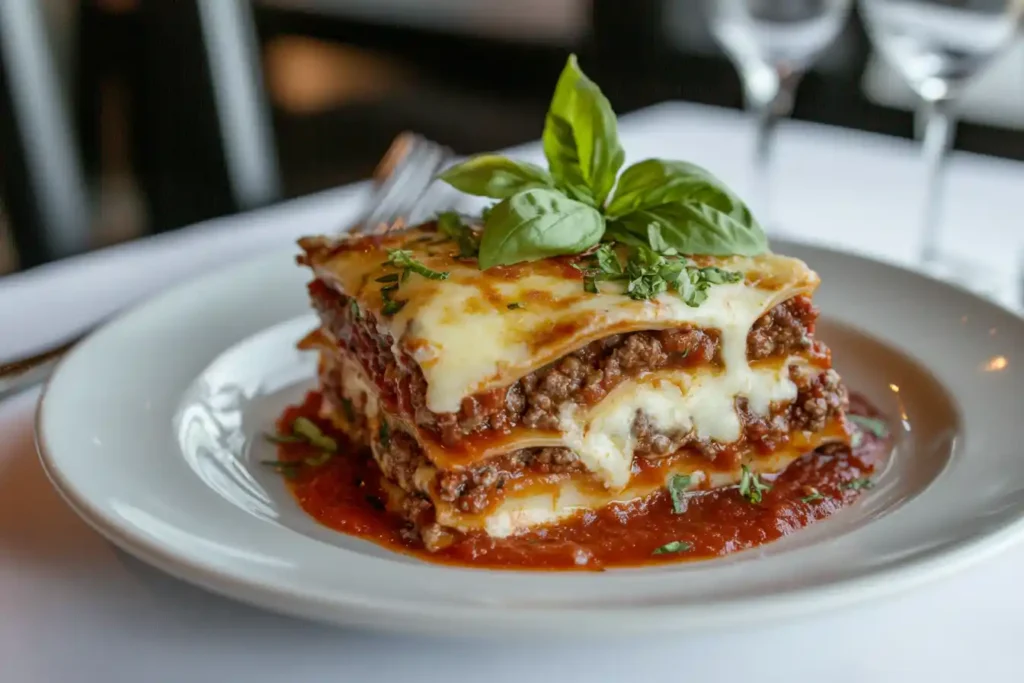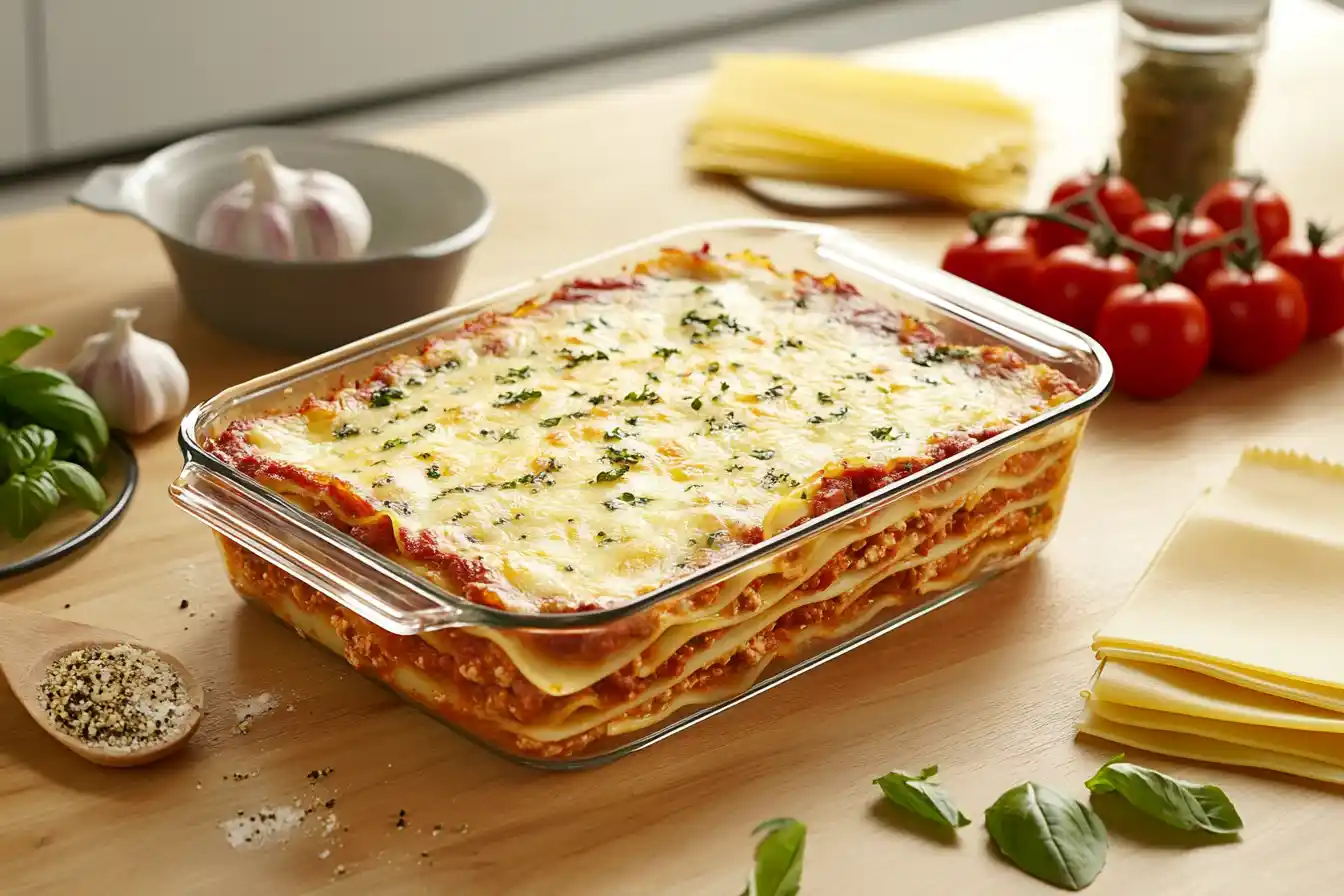Lasagna has long been a beloved comfort food, known for its layers of rich sauces, melted cheeses, and perfectly cooked pasta sheets. However, traditional lasagna preparation often involves pre-boiling the noodles, a step that can be both time-consuming and messy. Enter oven-ready lasagna noodles—a game-changer for home cooks looking to simplify the process without sacrificing flavor or texture.
Oven-ready lasagna noodles are pre-cooked and dried during manufacturing, eliminating the need for boiling. They’re designed to absorb moisture from sauces during baking, making them incredibly convenient. But what makes them so special? Are they just as good as traditional noodles? And how do you ensure they cook perfectly every time?
This comprehensive guide dives deep into everything you need to know about oven-ready lasagna noodles—from what they are and how to use them to recipes, tips, and troubleshooting techniques. Whether you’re a novice in the kitchen or an experienced chef, this article will help you master the art of lasagna with ease.
Table of Contents
What Are Oven-Ready Lasagna Noodles?
Definition and Origin of Oven-Ready Noodles
Oven-ready lasagna noodles, also known as no-boil lasagna sheets, are pasta sheets that have been pre-cooked and dehydrated during the manufacturing process. Unlike traditional lasagna noodles, which require boiling before layering, oven-ready noodles are designed to soften and cook as they absorb moisture from sauces and fillings in the dish.
Originally introduced as a time-saving option for busy cooks, these noodles have grown in popularity, offering convenience without compromising flavor or texture. They are especially useful for preparing lasagna in advance or creating quick, weeknight meals.
Key Features of Oven-Ready Lasagna Noodles
- Pre-Cooked and Dried:
These noodles are partially cooked and then dried, allowing them to rehydrate during baking. - Thin and Flat Design:
Their thinner profile ensures they cook evenly and absorb moisture effectively. - No Pre-Boiling Required:
They can be used straight out of the box, simplifying preparation. - Compatible with Various Sauces:
From meat sauces to vegetarian options, these noodles work well with a range of flavors.
Differences Between Oven-Ready and Traditional Lasagna Noodles
| Feature | Oven-Ready Lasagna Noodles | Traditional Lasagna Noodles |
|---|---|---|
| Preparation Time | No boiling required; ready to layer. | Requires pre-boiling before layering. |
| Thickness | Thinner for faster cooking. | Thicker, may require longer baking. |
| Moisture Absorption | Absorbs liquid during baking. | Pre-cooked, retains less moisture. |
| Convenience | Ideal for quick, hassle-free meals. | Better for traditional recipes. |
While traditional noodles may offer slightly more flexibility in texture, oven-ready noodles are ideal for busy households or those looking to streamline their cooking process.
Advantages of Using Oven-Ready Lasagna Noodles
Convenience and Time-Saving Benefits
One of the biggest reasons home cooks opt for oven-ready lasagna noodles is their convenience. Traditional lasagna requires boiling noodles, draining them, and then assembling the dish—steps that can take up significant time. With oven-ready noodles, you skip the boiling step entirely, cutting preparation time in half.
Additionally, since these noodles absorb moisture as they cook, you can create lasagna in fewer dishes, minimizing cleanup. Imagine assembling your lasagna directly in the baking dish and popping it in the oven—no extra pots or strainers required!
Versatility in Recipes
Another fantastic advantage is the versatility of oven-ready lasagna noodles. They work well in a variety of dishes beyond traditional lasagna, including:
- Vegetable Lasagna – Layered with spinach, zucchini, and ricotta.
- Mexican-Inspired Lasagna – Featuring taco-seasoned beef, salsa, and cheese.
- Breakfast Lasagna – Loaded with eggs, bacon, and cheese for a morning twist.
Whether you prefer a classic Italian recipe or want to experiment with creative fillings, oven-ready noodles adapt beautifully.
How to Use Oven-Ready Lasagna Noodles
Step-by-Step Cooking Guide
Using oven-ready lasagna noodles is simpler than you might think, but following the right steps ensures your dish comes out perfectly every time. Here’s a step-by-step guide to preparing lasagna with oven-ready noodles:
- Preheat the Oven:
Begin by preheating your oven to the temperature specified in your recipe—usually around 375°F (190°C). - Prepare the Sauce:
Whether you’re making a traditional meat sauce, a vegetarian option, or a creamy Alfredo, ensure your sauce is slightly thinner than usual. Oven-ready noodles absorb liquid during baking, so having extra moisture is crucial to prevent dryness. - Grease the Baking Dish:
Lightly grease the bottom of your baking dish with olive oil or non-stick spray to avoid sticking. - Layer the Ingredients:
- Start with a thin layer of sauce at the bottom.
- Add a layer of oven-ready noodles, ensuring they don’t overlap.
- Spread a layer of ricotta or béchamel sauce, followed by shredded mozzarella or parmesan.
- Continue layering until you reach the top, ending with a generous layer of sauce and cheese.
- Cover the Dish:
Tightly cover the lasagna with aluminum foil to trap moisture. This helps soften the noodles evenly. - Bake to Perfection:
Bake for 45-50 minutes, covered. Then, uncover the dish and bake for an additional 10 minutes to create a golden-brown, bubbly cheese topping. - Rest Before Serving:
Allow the lasagna to rest for about 10-15 minutes before cutting into it. This helps the layers set, making it easier to serve neat slices.
Layering Techniques for Perfect Texture

Layering is the key to achieving that classic lasagna texture where each bite is balanced with noodles, sauce, and cheese. Here are some tips:
- Start and End with Sauce: Always begin with a thin layer of sauce to prevent the noodles from sticking to the dish and drying out. Finish with sauce and cheese to create a rich, flavorful top layer.
- Alternate Layers Strategically: Balance layers by alternating wet (sauce) and dry (noodles) elements. Too many dry layers may result in undercooked noodles, while too many wet layers can lead to soggy results.
- Don’t Overload Fillings: Avoid adding too much sauce or cheese, which can overwhelm the noodles and make slicing difficult.
Tips for Preventing Dryness or Sogginess
One of the most common concerns with oven-ready noodles is achieving the right texture. Follow these tips to avoid common pitfalls:
- Use Extra Sauce: Oven-ready noodles absorb liquid as they bake, so add an extra 1/2 to 1 cup of sauce than you normally would with traditional noodles.
- Soak the Noodles (Optional): If you’re unsure about moisture levels, you can briefly soak the noodles in warm water for about 5 minutes before layering. This softens them slightly and reduces the chances of dryness.
- Don’t Skip the Foil Cover: Covering the dish while baking traps steam, helping the noodles cook evenly. Only remove the foil in the final 10 minutes for browning.
- Check Doneness Before Serving: Insert a knife into the center of the lasagna to ensure the noodles are tender. If they still feel firm, bake for an additional 5–10 minutes.
Best Recipes with Oven-Ready Lasagna Noodles
Classic Meat Lasagna Recipe

Ingredients:
- 1 lb ground beef or Italian sausage
- 1 jar (24 oz) marinara sauce
- 1 container (15 oz) ricotta cheese
- 2 cups shredded mozzarella cheese
- 1 cup grated parmesan cheese
- 1 egg
- 1 box oven-ready lasagna noodles
- Fresh basil for garnish
Instructions:
- Brown the meat in a skillet and drain excess fat. Stir in marinara sauce and simmer for 10 minutes.
- Mix ricotta, egg, and 1/2 cup parmesan in a bowl.
- Spread 1/2 cup meat sauce at the bottom of a baking dish. Add a layer of noodles, ricotta mixture, and mozzarella. Repeat layers.
- Top with remaining sauce and cheeses.
- Cover with foil and bake at 375°F (190°C) for 45 minutes. Uncover and bake an additional 10 minutes.
- Let it rest for 10 minutes before serving.
Vegetable Lasagna Recipe
Ingredients:
- 1 zucchini, thinly sliced
- 1 yellow squash, thinly sliced
- 1 red bell pepper, diced
- 1 jar (24 oz) marinara sauce
- 1 container (15 oz) ricotta cheese
- 2 cups shredded mozzarella cheese
- 1 egg
- 1 box oven-ready lasagna noodles
Instructions:
- Sauté vegetables until tender.
- Mix ricotta, egg, and 1/2 cup mozzarella.
- Layer sauce, noodles, ricotta mixture, and vegetables. Repeat layers.
- Top with sauce and cheese. Bake at 375°F (190°C) for 45 minutes covered, then 10 minutes uncovered.
Cheesy Spinach Alfredo Lasagna
Ingredients:
- 1 jar Alfredo sauce
- 1 container (15 oz) ricotta cheese
- 1 package (10 oz) frozen spinach, thawed and drained
- 2 cups shredded mozzarella cheese
- 1 egg
- 1 box oven-ready lasagna noodles
Instructions:
- Mix ricotta, spinach, egg, and 1 cup mozzarella.
- Spread Alfredo sauce at the bottom of a baking dish.
- Layer noodles, spinach mixture, and sauce. Repeat until full.
- Top with sauce and remaining cheese.
- Bake covered for 45 minutes, then uncovered for 10 minutes.
Common Mistakes to Avoid with Oven-Ready Lasagna Noodles
Overcooking or Undercooking Issues
One of the most frequent problems when using oven-ready lasagna noodles is achieving the right texture—neither too soft nor too firm. Here’s how to avoid these pitfalls:
- Avoid Overbaking: Oven-ready noodles cook quickly, so baking them for too long can make them mushy. Stick to the recommended baking time of 45–50 minutes, plus 10 minutes uncovered for browning.
- Test for Doneness Early: Insert a knife or fork into the center of the lasagna at the 40-minute mark. If the noodles are tender, you can proceed to uncover and finish baking.
- Check Sauce Consistency: Too-thick sauces may not provide enough moisture for the noodles to soften properly, leaving them undercooked. Make sure your sauce is slightly watery to compensate for moisture absorption.
Improper Sauce Usage
The sauce plays a crucial role when cooking with oven-ready noodles. Errors in sauce preparation or layering can lead to dryness or unevenly cooked noodles.
- Thin, Moist Sauce Is Essential: Since oven-ready noodles rely on moisture to cook, a dry or thick sauce won’t provide enough liquid. Adding 1/2 cup of water or broth to the sauce can help maintain moisture levels.
- Spread Sauce Evenly: Make sure each layer of noodles is completely covered with sauce to prevent dry spots. Skipping this step may cause parts of the noodles to remain hard after baking.
- Don’t Over-Sauce: While moisture is important, adding too much sauce can make the lasagna soggy. Aim for balance by lightly coating each layer.
Top Brands of Oven-Ready Lasagna Noodles
Choosing the right brand of oven-ready lasagna noodles can make a big difference in your dish’s texture and flavor. Here’s a quick review of some of the most popular options:
Barilla Oven-Ready Lasagna Noodles
Features:
- Widely available and affordable.
- Flat, thin sheets designed for even baking.
- No pre-soaking required.
Pros:
- Reliable texture and flavor.
- Easy to layer without breaking.
- Holds shape well after baking.
Cons:
- Slightly more expensive than generic brands.
Ronzoni No-Boil Lasagna Noodles
Features:
- Ridged texture helps grip sauces better.
- Cooks evenly without pre-boiling.
Pros:
- Budget-friendly option.
- Firm texture with good moisture absorption.
Cons:
- Slightly thicker than other brands, requiring more sauce.
Trader Joe’s No-Boil Lasagna Noodles
Features:
- Organic and non-GMO options available.
- Thin sheets for delicate layering.
Pros:
- Great for healthier recipes.
- Delivers a homemade feel and flavor.
Cons:
- Limited availability outside Trader Joe’s stores.
FAQs About Oven-Ready Lasagna Noodles
1. Do I Need to Soak Oven-Ready Lasagna Noodles?
No, soaking is not necessary as long as your sauce contains enough moisture. However, if you’re worried about dryness, you can briefly soak the noodles in warm water for 5 minutes before layering.
2. Can I Use Oven-Ready Noodles in Any Lasagna Recipe?
Yes! Simply skip the boiling step and ensure your recipe includes enough sauce or liquid to allow the noodles to rehydrate during baking.
3. How Do I Prevent My Lasagna From Being Too Dry?
Add extra sauce, cover your lasagna with foil while baking, and check for doneness early to avoid drying out the noodles.
4. Can I Freeze Lasagna Made with Oven-Ready Noodles?
Absolutely. Assemble your lasagna and freeze it before baking. When ready to cook, bake directly from frozen at 375°F (190°C) for 60–70 minutes or until heated through.
5. Are Oven-Ready Noodles Gluten-Free?
Some brands offer gluten-free versions, but always check the packaging for dietary labels. Popular gluten-free brands include Barilla Gluten-Free Lasagna and Jovial Foods.
6. Can I Use Oven-Ready Noodles for Dishes Other Than Lasagna?
Yes! Oven-ready noodles can be used in recipes like baked pasta casseroles, roll-ups, and even dessert lasagnas with sweet fillings like mascarpone and berries.
Conclusion
Oven-ready lasagna noodles have revolutionized the way we prepare one of the most beloved comfort foods. Their convenience, versatility, and time-saving benefits make them an excellent choice for busy home cooks and culinary enthusiasts alike.
From traditional meat lasagna to creative vegetarian and Alfredo variations, oven-ready noodles provide endless possibilities without the hassle of boiling. By following the tips and recipes outlined in this guide, you can master the art of lasagna and impress family and friends with delicious, perfectly layered dishes.
Whether you’re a novice experimenting in the kitchen or an experienced chef looking for shortcuts, oven-ready lasagna noodles are a reliable ingredient that simplifies cooking without sacrificing flavor. So, grab your favorite brand, prep your ingredients, and get ready to enjoy a slice of lasagna perfection!
Love pasta dishes? Explore Black Bean Noodles Guide for a healthy twist, or learn how to make Roasted Tomatoes for Pasta Sauce to complement your lasagna. Don’t miss our tips on Best Tomatoes for Pasta Sauce for more flavorful recipes!

